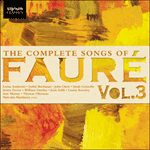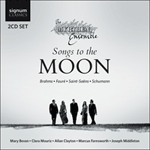To close his second period, and open the doors into his third, Fauré composes what is for many people the quintessential French mélodie. The poem (the opening of Verlaine’s
Fêtes galantes, 1869) is a flawless jewel, and the music follows suit. Debussy had already set the text for his mistress, the soprano Blanche Vasnier, in 1881 – a menuet with the charm of Massenet. Debussy’s second version, from
Fêtes galantes, the mature master at the top of his form, was composed in 1891. Between these, in terms of chronology, is Fauré’s song – sublimely indifferent to his rival’s earlier setting, and unperturbed by the later. The two are worlds apart: Debussy uses five sharps, Fauré five flats, the irreplaceable colour of B flat minor. This
Clair de lune stands in the hearts and ears of many listeners as a kind of definition of the French mélodie – similar to Schubert’s
Gretchen am Spinnrade settings in the German lied. The high profile of the piano-writing in both songs is no coincidence. Watteau’s paintings of courtly revels in the gardens of Versailles set the tone; Fauré responds with that air of tenderness, boredom and distance which is the nineteenth century’s view of the eighteenth. Time-travel of this kind is familiar enough, but not one of the many minuets, sarabandes and bourdons that abound in French song can match
Clair de lune. Under the unruffled surface of this music, passion and spontaneity are tightly corseted by etiquette and intrigue. Jankélévitch sees in Fauré’s simulated indifference an iron fist in a velvet glove. It was Ravel who noted that the phrase ‘mode mineur’ strays into the major key, perhaps a musical metaphor for the fact that the suave words of a courtier never mean what they say. After the celebrated twelve-bar introduction, voice and piano perform a nonchalant pas de deux, sometimes coalescing (as at ‘Au calme clair de lune triste et beau’) yet always seeming to lead independent existences. Verlaine’s poem reflects the chasm between public utterance and private life; he who writes poems of courtly love is not necessarily a courtly lover. The solitary melancholy in this song seems apt for an unhappily married composer for whom the scandal of divorce was unthinkable. Whatever pleasure is arranged au clair de lune it will be felt at one remove; the thrill of pursuit is already marred by the certainty of the final parting.
from notes by Graham Johnson © 2005
Pour clore sa deuxième manière, et ouvrir la porte sur sa troisième, Fauré composa ce que beaucoup considèrent comme la quintessence de la mélodie française. Le poème (qui inaugure Les
Fêtes galantes de Verlaine, 1869) est un parfait joyau, tout comme la musique. Debussy avait déjà mis ce texte en musique pour sa maîtresse, la soprano Blanche Vasnier, en 1881 – il en ressortit un menuet charmant comme du Massenet. Une seconde version, issue des
Fêtes galantes (1891), le montrera en maître abouti, au summum de sa forme. Chronologiquement parlant, la mélodie de Fauré se situe entre ces deux moutures de son rival – sublimement indifférente à la première, impassible face à la seconde. Les deux compositeurs sont à des univers de distance: Debussy utilise cinq dièses et Fauré cinq bémols, l’irremplaçable couleur de si bémol mineur. Ce
Clair de lune incarne, dans le cœur et les oreilles de bien des auditeurs, une manière de définition de la mélodie française, occupant une position comparable à celle des mises en musique schubertiennes de
Gretchen am Spinnrade dans le lied allemand. La valorisation de l’écriture pianistique est, dans les deux cas, tout sauf un hasard. Les tableaux de Watteau, représentations des menus plaisirs de cour dans les jardins de Versailles, donnent le ton; Fauré y répond par cet air de tendresse, d’ennui et de détachement qui reflète la perception dix-neuviémiste du XVIIIe siècle. Ce genre de voyage dans le temps n’est pas rare, mais aucun des pléthoriques menuets, sarabandes et bourdons de la mélodie française ne saurait égaler
Clair de lune. Sous l’étale de cette musique, la passion et la spontanéité sont corsetées serré par l’étiquette et par l’intrigue. Jankélévitch voit dans l’indifférence feinte de Fauré une main de fer dans un gant de velours. Ravel, lui, remarqua que les mots «mode mineur» se retrouvent en majeur, possible métaphore musicale du fait que les paroles doucereuses d’un courtisan ne veulent jamais dire ce qu’elles disent. Passé la célèbre introduction de douze mesures, voix et piano exécutent un nonchalant pas de deux, se fondent parfois (comme à «Au calme clair de lune triste et beau»), mais semblent toujours mener des existences indépendantes. Le poème de Verlaine reflète l’abîme qui sépare expression publique et vie privée: quiconque écrit des poèmes d’amour courtois n’est pas forcément un courtisan. La mélancolie solitaire de cette mélodie sied à un compositeur malheureux en ménage, pour qui le scandale d’un divorce était inconcevable. Quel que soit le plaisir prévu au clair de lune, il sera éprouvé avec une certaine distance: le frisson de la quête est déjà entaché par la certitude de la séparation finale.
extrait des notes rédigées par Graham Johnson © 2005
Français: Hypérion


 Fauré: The Complete Songs, Vol. 3
Fauré: The Complete Songs, Vol. 3 Songs to the moon
Songs to the moon Visions illuminées
Visions illuminées
